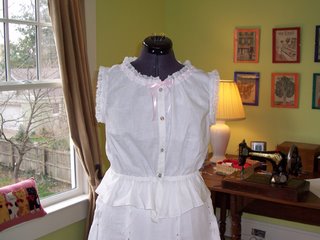 The corset cover is complete. Here it is at left. Compare this image to the photograph of the original in the 1911 textbook I drafted it from, which appears below. I think they are quite close, with one exception. I have a 30-inch waist, and the original was for a 24-inch waist.
The cover is comfortable to wear, and fits as it should, which is a relief!
I believe this is a typical schoolgirl-type corset cover, utilitarian and effective under opaque shirtwaists or bodices, but not meant for dress-up wear by any means.
The corset cover is complete. Here it is at left. Compare this image to the photograph of the original in the 1911 textbook I drafted it from, which appears below. I think they are quite close, with one exception. I have a 30-inch waist, and the original was for a 24-inch waist.
The cover is comfortable to wear, and fits as it should, which is a relief!
I believe this is a typical schoolgirl-type corset cover, utilitarian and effective under opaque shirtwaists or bodices, but not meant for dress-up wear by any means. Lessons Learned...for Next Time
- Unlike many popular corset covers of the period, on this one the shoulders are quite wide. Next round I would cut them in so that the lace and fabric didn't come out over the shoulder curve. When wearing a tight sleeve the extra fabric would tend to get in the way.
 I would retain the front fullness in this pattern. Worn under an original sheer batiste shirtwaist of bloused cut, the cover helps to hold out the front fullness nicely. By this point some shirtwaists still had a bit of blousing, while others were smooth-fronted. Speaking of which, those shirtwaists are awfully fashionable in 2006. The lace, the sheerness -- worn with a cami (just a modern version of a corset cover) it could have been made today! CAbi in fact has a blouse in their line this spring that could have been made between 1912-1920.
I would retain the front fullness in this pattern. Worn under an original sheer batiste shirtwaist of bloused cut, the cover helps to hold out the front fullness nicely. By this point some shirtwaists still had a bit of blousing, while others were smooth-fronted. Speaking of which, those shirtwaists are awfully fashionable in 2006. The lace, the sheerness -- worn with a cami (just a modern version of a corset cover) it could have been made today! CAbi in fact has a blouse in their line this spring that could have been made between 1912-1920.- The peplum is also useful as it helps to hold the cover in place under a skirt waistband. Practical!
- For this trial piece I used plain, 99-cent 100% cotton muslin. Next time I would use a fine 199% cotton batiste. The muslin is too heavy, and the threads and weave too coarse to be attractive under a lawn, handkerchief linen, or batiste shirtwaist, especially a vintage one. All of these fabrics are really, really sheer. So the inferior grade of the muslin beneath is apparent. Further, it's too stiff by comparison and again, you can actually see that the two "don't go" when worn together. Above, the original corset cover, from Text-Book on Domestic Art, 1911, p. 87. Available on Cornell University HEARTH site.
- The lace I used, while cotton, is also too stiff. Washing it a great deal might help, but in future I will use a finer, thinner lace that won't frill so aggressively under a fine lawn shirtwaist.
- I'd wear this sort of pattern only under bloused shirtwaists. A much smoother, lower-fronted, and closer-cut version would be appropriate with a dress.


No comments:
Post a Comment